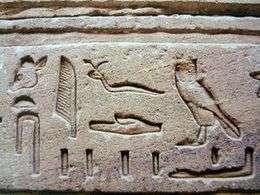hieroglyphic
English

Alternative forms
- hieroglyphick (obsolete)
Etymology
First coined 1726, from Middle French hiéroglyphique, from Latin hieroglyphicus, from Ancient Greek ἱερογλυφικός (hierogluphikós), from ἱερογλυφέω (hierogluphéō, “to represent hieroglyphically”), from ἱερός (hierós, “sacred, holy”) + γλύφω (glúphō, “to carve, to engrave, to cut out”)
Pronunciation
- IPA(key): /ˌhaɪɹəˈɡlɪfɪk/
- Rhymes: -ɪfɪk
Noun
hieroglyphic (plural hieroglyphics)
- (chiefly in the plural) a writing system of ancient Egypt, Minoans, Maya and other civilizations, using pictorial symbols to represent individual sounds as a rebus
- any symbol used in this system; a hieroglyph
- (by extension) undecipherable handwriting or secret symbol
Usage notes
The use of this word in the plural, as well as its use to mean ‘a hieroglyph’, are commonly proscribed by Egyptologists; for example, James P. Allen writes, ‘Each sign in this system is a hieroglyph, and the system as a whole is called hieroglyphic (not “hieroglyphics”).’ Thus, while the use of ‘hieroglyphics’ is quite common in works written by laymen (and formerly in 19th-century academic works), it is rare in modern academic works written by Egyptologists.
Translations
|
|
Adjective
hieroglyphic (comparative more hieroglyphic, superlative most hieroglyphic)
- of, relating to, or written with this system of symbols
- hieroglyphic writing
- hieroglyphic obelisk
- difficult to decipher
Translations
|
|
|
|